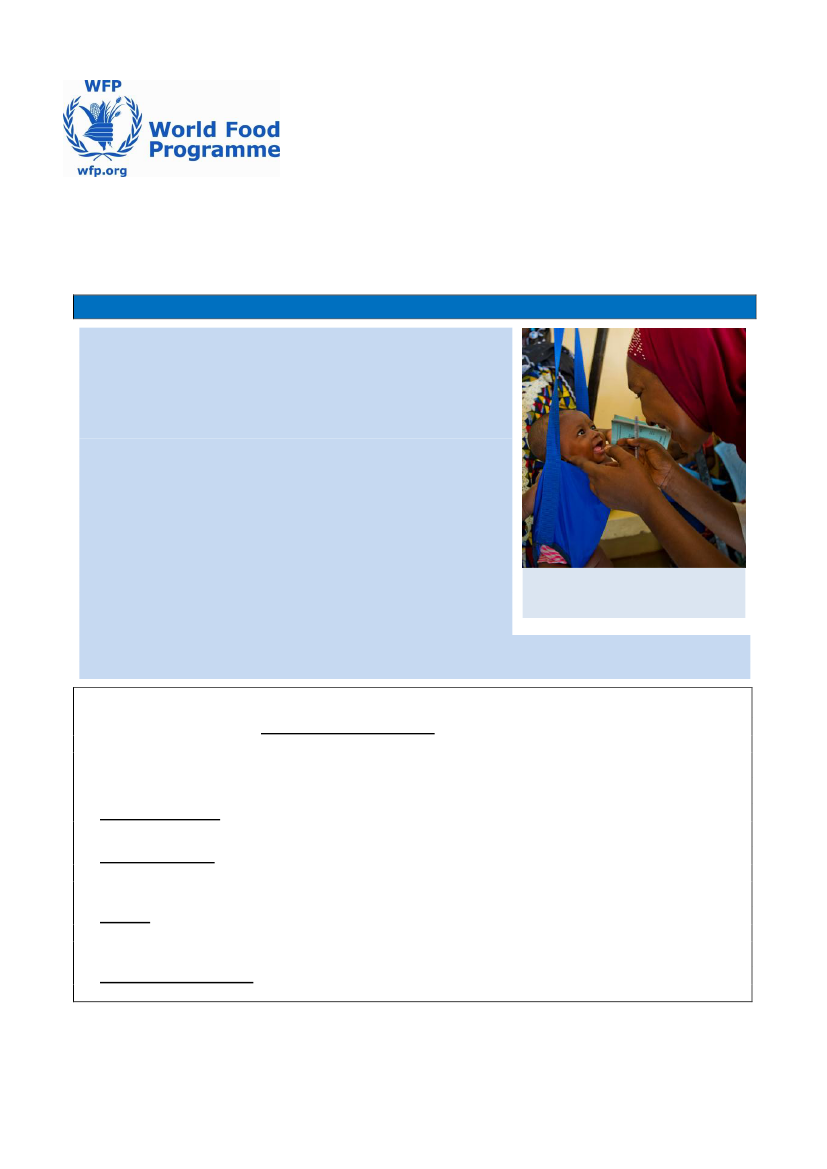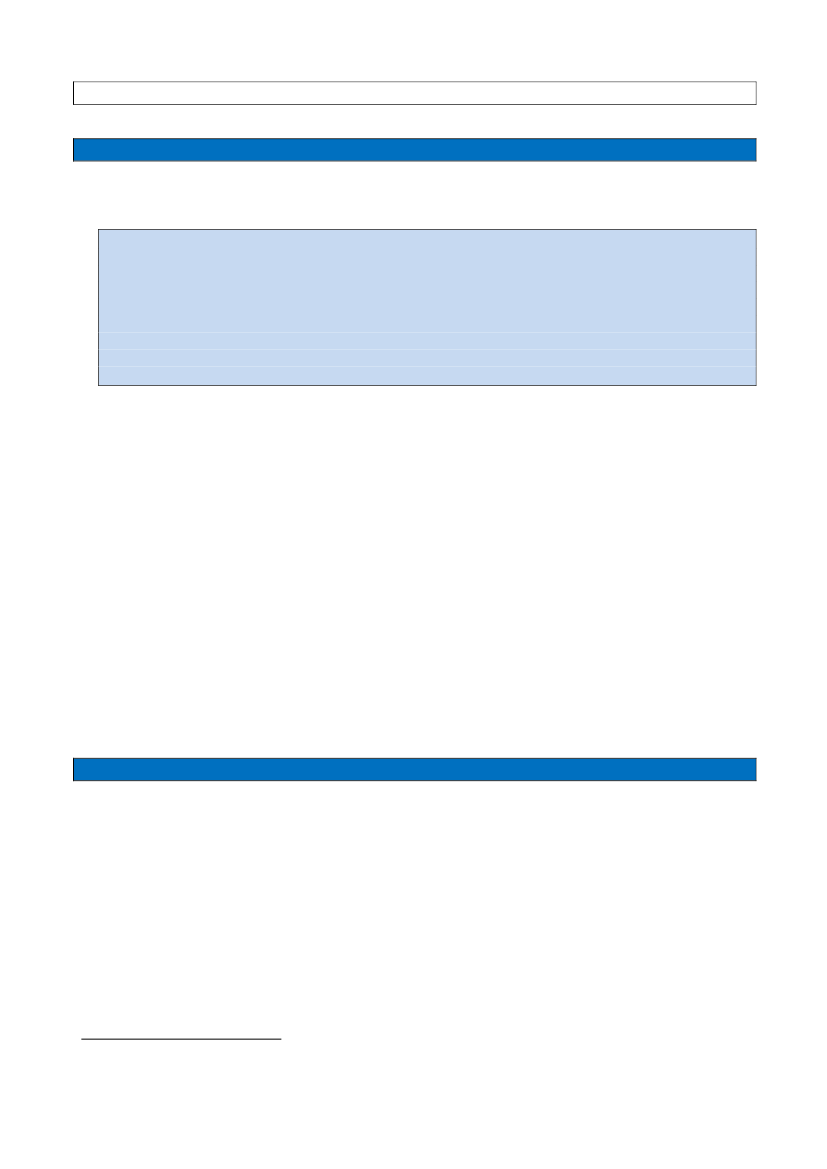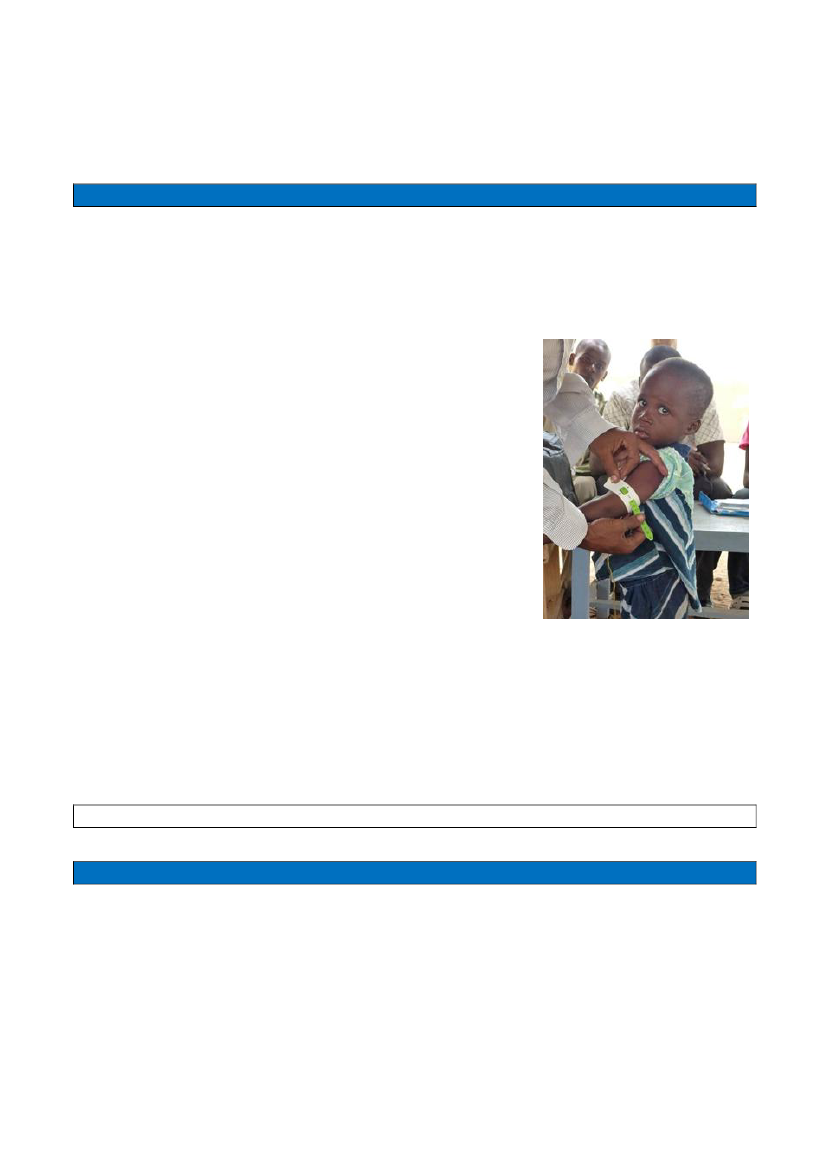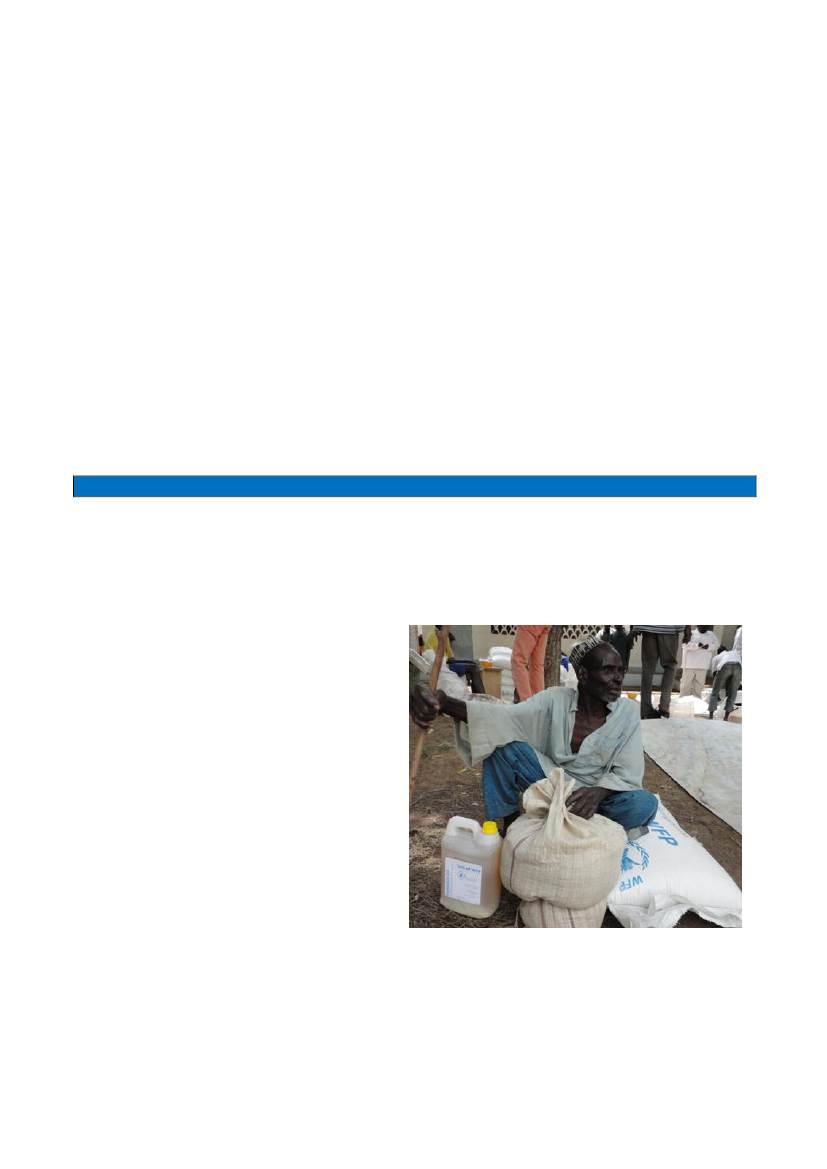Udenrigsudvalget 2012-13
URU Alm.del Bilag 29
Offentligt
Sahel Update No. 39Regional Bureau for West Africa26 October 2012Food and nutrition response to the 2012 Sahel crisisBurkina Faso, Cameroon, Chad, Mali, Mauritania, Niger, Senegal, and The Gambia
OverviewTo date,harvest has started in most locations,and overall, cropprospects are favorable. Nevertheless, communities remain weakenedafter months of hardship during a lean season that was longer and moredifficult than usual. The drought that affected the Sahel this year hadexacerbated an already difficult situationamong communities that hadlittle time to recover from the past crises in 2009/2010 and 2005.Even though through the crisis response,nutrition and food securityindicators may have improved(following initial analysis) in certainareas,they remain at unacceptably high levels.Therefore, concerted and multi-sectoral action is neededto address theroot causes of food and nutrition insecurityto strengthen communities’resilienceto future shocks.During the lean season when needs were greatest, WFP supportedbetween five and six million peopleeach month. These activities werein addition to mitigation activities carried out prior to the lean season. InSeptember alone, 6.1 millionpeople were reached.To date,activities are gradually shiftingto longer term interventions.Crop assessments will be conducted in all Sahel countries by CILSS/FAO/WFP/FEWSNETby the end of October.Nutrition screening in health centre, Niger.WFP/Anne Poulsen
Mali crisis:The Mali crisis has triggeredadditional and complex needsamong displaced and host populations in Burkina Faso,Mali, Mauritania and Niger, where communities were already weakened by this year’s drought. The operationalcontext in Northern Mali remains challenging, and is increasingly becoming so in the neighbouring countries.Over200,000 people are displaced in Mali,and some200,000 fledto Burkina Faso, Mauritania and NigerWFP support so far:In response to these additional needs, WFP has so far supported over200,000 refugees,74,000 IDPs and 182,000 non-displaced conflict affected peoplein Northern Mali.The Regional EMOP(assistance to IDPs and Malian refugees) initially planned to support up to 555,000 people inBurkina Faso, Mali, Mauritania and Niger, and is currently being reviewed for extension into 2013; figures will berevised in view of the current situation and scenarios for the next months.Funding:Critical funding gaps remain for the Regional Emergency Operation to provide urgent food and nutritionassistance to displaced people (shortfalls until December amount 25 percent or US$19.5 million). In view of theupcoming extension, requirements will further increase.The risk of locust invasioncontinues to be monitored and control operations are being carried out mainly in Nigerand Chad. Swarms are expected to migrate further north and north-west with the end of the rainy season.
Note: This week’s update provides an overview of WFP’s response to the Sahel crisis in September, as well as a few highlights ofthe response in October. For more specific information please contact the Regional Bureau in Dakar (p.4).
1
Food and nutrition assistance in September – Sahel regionOverviewsLean season activities - unconditional targeted food and cash/voucher distributions as well as blanketsupplementary feeding programmes – are about to come to an end in most areas as focus is shifting to longerterm activities addressing root causes, strengthening people’s resilience to future crisis.In September, WFP has supported 6.1 million peoplethrough food and nutrition activities. Throughout the leanseason,WFP has supported each month between five and six million people through its nutrition and food1security activities. This was the period when needs were greatest and the risk for vulnerable groups (includingchildren under 5 years and pregnant women and nursing mothers) to fall into acute malnutrition were highest.Under the activities aiming at preventing and treating moderate acute malnutrition,WFP saw between one and1.5 million children and women attend health centres and distributions sitesfor their nutritious food rationseach month. Throughtargeted food/cash based assistance, five million peoplewere supported in Septemberalone.90,000 people were supported through food for work;this activity will be further scaled up in the comingmonths as unconditional assistance is phasing down.Although communities are just starting to recover from this year’s crisis and remain weakened - harvest hasbegun in most areas - a positive impact of these activities has already been noted in some areas, and surveysbeing finalized have confirmed that in Niger for example, GAM rates have overall improved in areas where thepreventive programmes were implemented (with localized exceptions). Undoubtedly, early preparedness andaction among concerned actors have been positively contributing to these results.Nevertheless, despite the above improvement, malnutrition rates remain unacceptably high, generally classifiedas ‘serious’ in most regions of the Sahel. Therefore, in order to achieve a durable reduction in these rates and toobserve a positive impact on these children’s livelihoods in the long-term,continued and concerted efforts areneeded by all actors beyond this crisis response to support nutrition and food security activities in the Sahel -alongside efforts contributing to resilience to future shocks.Assessments to determine levels of food insecurity and nutrition are being conducted in all Sahel countries in thecoming weeks in close collaboration with governments and partners, in order to shape the upcoming phase ofthe response after the harvest.CILLS/FAO/WFP and FEWSNET are conducting crop assessments in all 17countries of the region;joint missions in the Sahel countries will be carried out end of October/early November,and results will be presented at the PREGEC meeting on 19 – 21 November.Concurrently, post-distribution monitoring surveys (PDM) are being conducted/finalized to evaluate activitiesimplemented so far. A series of SMART surveys are being carried out/were carried out to contribute to theunderstanding of the nutrition situation.
Food securityIn September, food security activities were in their final stages of implementation while preparing for the transitionfrom typical lean season activities to longer term food-for-work activities. WFP food security activities are seasonallytimed, aligned with communities’ agricultural calendars and tailored to specific livelihood zones and groups.Under unconditional activities,critical during the lean season when it is most difficult for families to ensure anadequate quantity and quality of meals for all household members,WFP supported three million people throughtargeted food distributions;in addition, 1.8 million people were provided with cash/voucher transfers in areaswhere markets were functional. Furthermore, over 200,000 people displaced following the Mali crisis (internallydisplaced people in Mali and refugees in Burkina Faso, Mali, Mauritania and Niger) were supported with vitalfood and nutrition support.Alongside these activities,90,000 people participated in food-for-work activities in Senegal, Chad and Mali.These activities will be further scaled up in the coming weeks, when rural communities’ involvement inagricultural activities is decreasing.
1
People may participate in one or more activities over several months, so numbers should not be added up. The total of 8 million mentioned hereis the consolidated total excluding double-counting.
Note: This week’s update provides an overview of WFP’s response to the Sahel crisis in September, as well as a few highlights ofthe response in October. For more specific information please contact the Regional Bureau in Dakar (p.4).
2
Heavy rains across the region led to the growth of crops and pasture,but also resulted in localised flooding,causing the destruction of homes and the inundation of fields. In Burkina Faso, Chad, Cameroon, Niger andSenegal, this situation has most affected WFP operations. WFP has provided assistance to affected populations aspossible and needed.
NutritionIn the Sahel where malnutrition rates are above emergency levels even in non-crisis periods, the hardship during thelean season puts the lives of many children at risk. Therefore, preventive nutrition assistance through blanketsupplementary feeding, as well as treatment for those already suffering from moderate acute malnutrition was vitalfor millions of children and pregnant women and nursing mothers.In September, WFP provided 1.1 million people with such assistance; during the previous months of the leanseason, 1.5 million beneficiaries were supported each month.More specifically, nearly 900,000 children and pregnant women andnursing mothers in Burkina Faso, Cameroon, Chad, Mali, Niger and TheGambia received nutritious foods through the blanket supplementaryfeeding programme to prevent acute malnutrition.Alongside this programme, over 500,000 children and pregnant womenand nursing mothers were provided with nutritious products to treatmoderate acute malnutrition under the targeted supplementary feedingprogramme, implemented all year round, but scaled-up during the leanseason in Burkina Faso, Cameroon, Chad, Mali, Mauritania, Niger andSenegal.While preliminary indications confirm that GAM rates have improved insome locations where preventive nutrition activities were implemented,they still remain high. In Niger for example, post distribution monitoring(PDM) revealed that Global Acute Malnutrition (GAM) rates observedamong beneficiaries of the blanket supplementary feeding programmeindicate a significant improvement in their nutritional status, decreasingfrom 20.8% in June to 14.0% at the time of the second PDM exercise in August. For the assisted children, rates nolonger surpass the WHO emergency threshold of 15%. The regions ofMUAC screening under blanketMaradi and Zinder remain of concern, reporting rates of 16.4% and 19.8%supplementary feeding programme inrespectively.Kayes region, Mali. WFP/Margit Bach.
As these rates still remain unacceptably high despite the aboveimprovement, continued nutrition support and multisectorial efforts are needed to address the persistently highmalnutrition rates in the Sahel. Eventually, improved nutrition among children is expected to contributepositively to their livelihoods and health when they are adults, hence rendering them more resilient to shocks.
Operational highlights of food and nutrition assistance in OctoberNutritionBurkina Faso:Over the past two weeks, WFP provided nutritional support to 48,157 children with blanket feeding and16,477 children and 5,052 nursing mothers through targeted supplementary feeding activities. Due to poorroad conditions, the blanket feeding delivery and distribution was delayed in certain districts.
Cameroon:The rising water levels of the Logone River continue to have a severe effect on the residents of surroundingvillages and neighborhoods. Initial estimations assert that as many as 8,238 people are affected by theseincreasing water levels in the Kousseri district.
Note: This week’s update provides an overview of WFP’s response to the Sahel crisis in September, as well as a few highlights ofthe response in October. For more specific information please contact the Regional Bureau in Dakar (p.4).
3
Over the last week, WFP and its distribution partners have provided food assistance to 5,306 men and 5,200women (1,472 households). Thus far in October, WFP has provided targeted supplementary feeding to 1,406children, 666 women, and blanket supplementary feeding to 8,565 children and 4,582 women.
Mali:In the South of the country, the last round of blanket supplementary feeding to drought affected populationswas completed in September for 104,700 children aged 6 to 23 months and 37,700 pregnant and lactatingwomen.In the North, blanket supplementary feeding continues for children aged 6 to 59 months as well as pregnantand lactating women. The increased child age group (from 6-23 months to 6-59 months) has been decidedbased on the fact that full functionality of the health centers cannot be assured. This will allow for protectionof the most vulnerable against acute malnutrition. During the month of September, in the occupied North,22,600 children aged 6-59 months have been assisted as well as 9,700 pregnant and lactating women.
Niger:WFP is reviewing its performance of the nutrition activities in 2012 to integrate lessons learned into futureprogrammes, a meeting for this purpose was held in Zinder. Preparations for the targeted supplementaryfeeding programme in 2013 were launched, and partners for these activities are being selected.The preliminary results of the BSF coverage survey were presented on Friday 19 October internally, and willbe shared with partners after integration of the final inputs.
Food securityBurkina Faso:Nearly 180,000 beneficiaries were supported with cash transfers and 450,000 people with food rations in thepast two weeks. However, the delivery of food in Komondjari, in the East of Burkina Faso, was delayed overdue to impassable roads to the distributions sites resulting from heavy rains. At the height of the rainyseason, SO Fada used local motorbikes to overcome the inaccessibility in the same district.
MaliWith the opening of the 2012/2013 schoolyear, Emergency School Feeding is about tostart in 290 schools in southern Mali, incommunes identified by the Early WarningSystem as food insecure and hosting displacedpopulations.Resilience building activities such as food forassets continue throughout the five southernregions with more than 100,000 participants.
Mauritania:The Country Office has successfully tested anew system for the collection of data usingSmart Phones. This system will be used for thenext operations conducted by the countryoffice.A meeting with the African Risk Capacity (ARC) of the African Union was held this week in the presence ofAmbassadors and the Mauritanian government to identify how index insurance and contingency financingcan better contribute to the management of drought crises in Mauritania and the Sahel. This could inform afuture disaster management policy in the country.
Note: This week’s update provides an overview of WFP’s response to the Sahel crisis. For more specific information please contactthe Regional Bureau in Dakar (p.4).
4
NigerWFP Niger participated in events organized for the World Food Day in Tillaberi.UNHAS Niger has organized a first special flight to Arlit on Thursday 11th October for the EU delegation inNiamey, for the opening of the project of rehabilitation of the new hospital of Arlit (funded by the EuropeanFund for Development). Arlit, located in the extreme north of Niger, is not part of the UNHAS Niger regularschedule and it was the first time that one of our aircraft had to land to this remote locality.UNHAS Niger maintain its' monthly flight to Dirkou. This month, UNHAS Niger has supported the NGO HelenKeller International to transport and deliver 3 mt of medicine to this oasis located at 400 km from the Libyanborder.
ResourcingUnder the Sahel response (Regional Response Framework for the Sahel), US$703 million have been resourced of thetotal requirements of US$888 million. Current shortfalls amount to US$186.4 million (21%); in view of upcomingbudget revisions of most projects included under this response, the needs are however expected to increase.
WFP is grateful for the critical support provided to the Sahel region by multilateral donors, as well as of African Union,Andorra, Australia, Austria, Belgium, Brazil, Canada, China, Denmark, the European Commission, Finland, France,Gambia, Germany, Iceland, Ireland, Israel, Italy, Japan, Kingdom of Saudi Arabia, Kuwait, Liechtenstein, Luxembourg,the Netherlands, New Zealand, Norway, Republic of Korea, Romania, Senegal, South Africa, Spain, Sweden,Switzerland, United Kingdom, the United Nations Central Emergency Response Fund (CERF) and the United States.
Critical funding gaps remain for the Regional Emergency Operation 200438 covering Burkina Faso, Mali,Mauritania and Niger to enable WFP to provide urgent food and nutrition assistance to the Malian IDPs andrefugees fleeing the conflict in Northern Mali. The operation is funded at 75 percent (US$59 million),requiring an additional US$19.5 million (US$ 78.9 million total requirements) through December 2012.However, in view of the upcoming extension, requirements will further increase.Special logistics operations are instrumental to procure and dispatch large volumes of humanitarianassistance to people. WFP calls on its partners to strengthen their support as Sahel logistics operationsrequire some US$9 million until the end of the year.
Following on the lean season, in Niger, WFP is transitioning from life-saving relief under EMOP 200398 (April-September 2012), to livelihood recovery and nutrition treatment activities under PRRO 200051. WFP willgradually scale-up post-harvest cash and food-for-work activities for very poor households and expandongoing targeted supplementary feeding activities for children with moderate acute malnutrition and formalnourished pregnant women and nursing mothers. Pipeline shortfalls till June 2013 amount to someUS$180 million.
ContactRegional Bureau for West Africa, Senegal:Thomas Yanga, Regional Director, Dakar: +221 33 849 65 00, [email protected]Claude Jibidar, Deputy Regional Director, Dakar: +221 33 849 65 00, [email protected]
For further information: www.wfp.org
Note: This week’s update provides an overview of WFP’s response to the Sahel crisis. For more specific information please contactthe Regional Bureau in Dakar (p.4).
5





